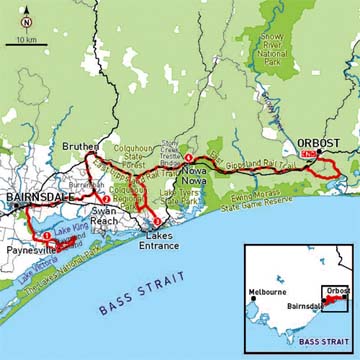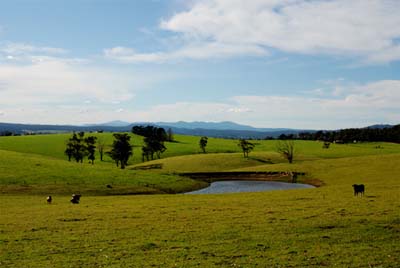
Hearty country fare, towering forests and wildlife are all part of life in East Gippsland, finds Karen Graham.
Cycling along the narrow silt jetties in East Gippsland, with the meandering Mitchell River on one side and the vast expanse of Lake King on the other, is a great way to start a four-day bike ride. Today, the waters are calm and glasslike; the surface reflecting wispy white clouds and patches of blue sky reminiscent of an Impressionist painting.
I’m travelling with Snowy River Cycling on their Lakes and Rail Trail tour, which promises diverse scenery, including rivers, lakes, farmlands and forest, and the chance to spot wildlife, as the route meanders along the old transport links of the railway line and waterways of the region.
Our journey begins at Eagle Point Bluff lookout, about 10km out of Bairnsdale, and there’s an incredible view of the lakes as we commence cycling. It’s only a short jaunt to reach the silt jetties and we ride along a narrow piece of land that stretches eight kilometres out into the lake. Until today, I’d never heard of silt jetties. They are finger-deltas formed over millions of years by silt deposits left behind as the river slows to enter the lake. Remarkably, the Mitchell River Silt Jetties are the second largest in the world, after the Mississippi River Silt Jetties on the Gulf of Mexico.
We cycle for about an hour before stopping for morning tea and quickly realise that food is another highlight of this tour, as we tuck into home-made lumberjack cake and steaming mugs of plunger coffee. I take the opportunity to chat to our group of eight riders, including Marlene, Keith and May, who live locally and are members of the ‘Friends of The East Gippsland Rail Trail’. This is fortunate for the rest of us, as they happily regale us with historical anecdotes about this region.
In the early days, supplies came to East Gippsland by sea and waterways (as the lakes connect all the way to Sale). Consequently, the railway came to the region quite late, with lines to Bairnsdale and Orbost opening in 1888 and 1916 respectively. The railway ceased operations in 1987, and the 94km rail trail between Bairnsdale and Orbost was developed (with the final section opening in 2006).
But this morning we cycle alongside Lake King from Eagle Point to Paynesville and then catch a ferry to Raymond Island, where we hope to spot koalas. They are so common out here that you can sometimes see them on jetties, piers and boats, but today we only find them in trees on the south-west corner of the island. I must admit, I never tire of seeing these cuddly creatures tucked into branches of eucalypts.
Our lunch break is in a beautiful spot overlooking Lake Victoria, before we continue riding around the island. In the narrow stretch of water between Raymond Island and Paynesville there are hundreds of sailing boats and our ride takes us past numerous jetties. With easy access to lakes, rivers and the ocean, it’s not surprising that aquatic sports are extremely popular in this region.
We drive back to Bairnsdale mid-afternoon to ride to Swan Reach via the East Gippsland Rail Trail. One the highlights is the view of the sprawling Nicholson River as we ramble across the historic Nicholson River Railway Bridge and, over dinner, Marlene tells us about the mysterious attempt to blow up this bridge in July 1958.

“Apparently eight charges were ignited and six exploded,” says Marlene. “Railway and Russell Street detectives investigated the incident and there was an article in The Sun newspaper, but no reason was offered for why the attempt was made. Around the time that this happened, several bridges on the Noojee line were burned down by sawmill mobs who were used to monopolising the transport of timber, so a link might be made to this. But I’ve been unable to find any further reports on this incident.”
“A few years ago I was instrumental in developing the Wilderness Bike Ride, a community run recreational cycle tour through remote East Gippsland,” says Liz. “I realised I was much more passionate about cycling than vetting, and from there it was a natural extension to develop my own business offering small group tours.”Most of Liz’s guided tours venture into the high alpine country and are reasonably challenging due to gravel roads, significant hill climbs and huge downhill runs; but the one I’ve joined is, according to Liz, “a gentle ride with only mild hills”.However, it’s the next 15km out of Bruthen that concerns me. A few months earlier, I rode this section after a night of torrential rain and the surface was soft and slippery. It was a tough ride, a gradual climb through the State Colquhoun Forest to the highest point of the trail. I recall thinking; this forest is so beautiful but I’m too cold, wet and miserable to stop and appreciate it. Even the downhill section was hard work because the tyres were sinking in the soft surface. Ironically, that ride was in summer, but today, on a late autumn morning, the weather is fine and the trail blissfully dry. Consequently, the ride is in complete contrast. Dare I say, easy!Just after the summit we divert onto the Gippsland Lakes Discovery Trail, which follows an old tramline down the valley of the Mississippi Creek towards Lakes Entrance. It’s an exhilarating ride along a narrower trail hemmed in by a forest of stringybark and silvertop-ash trees. I inhale the refreshing scent of eucalypt and listen to the sounds of birds overhead. After negotiating a sharp corner, I look up to see an amazing panorama of luminous green ferns on either side of the trail. This is the perfect way to spend a few days, particularly after a busy month at work, and I can feel the stress quietly slipping off my shoulders.During lunch, at Log Crossing, we listen to the lyrebirds as they mimic rosellas, wattlebirds and currawongs as part of their mating ritual. Unfortunately, we can’t linger too long, as swarms of mosquitos are relishing the opportunity to sting us.From here, it’s only about eight kilometres to our accommodation at Lakes Country Cottages and we have ample time to prepare for our cruise from Lakes Entrance to Wyanga Park Winery. Our host, Geoff, is a jovial fellow with a bushy white beard, rosy cheeks, and ample girth (exactly how you’d imagine a winemaker and restaurateur from an 18th century novel to look). It’s not too long before we are laughing merrily at his jokes; often at the expense of his wife’s unusual artwork displayed throughout the restaurant. We enjoy an enormous three-course meal with plenty of wine and good cheer; so much so that it’s a struggle to even walk to the bus afterwards. I wonder how on earth I will manage cycling tomorrow.Luckily, after two 50km days, our third day is a gentle 28km to Nowa Nowa. We ride via beautiful forestry tracks that take us back to the rail trail and alongside it. There’s a wonderful downhill run to the impressive Stony Creek trestle bridge, which was built in 1916 and is the longest and highest remaining timber trestle bridge in Victoria (247 metres long and 20 metres high).A few kilometres later, we veer off the rail trail to join the Nowa Nowa Walk for a taste of some ‘real’ mountain biking via a route with a rougher surface and steep sections. It’s a fun ride through a picturesque patch of forest dappled with sunshine wattle.Our afternoon is free for walking to the gorge or tackling trails in the Nowa Nowa Mountain Bike Park, but I choose to curl up with a book in front of a roaring fire. Our accommodation at Mingling Waters is in quaint wooden cottages and the owners, Mike and Jenny, cook us yet another substantial dinner – delicious slow-cooked lamb shanks and home-made apple pie.On our final day, we ride about 40km on the rail trail before detouring onto some minor roads around Orbost for another 20km. It’s our longest ride and, once again, we travel through wonderful countryside. At our morning break, we spot yellow-tailed cockatoos high in the trees, and later, see a goanna on the trail. We ride through forest that’s recovering from a recent bushfire; brilliant green leaves bursting to life from the blackened tree trunks.Finally, we leave the trail to ride through rich farmlands to the banks of the mighty Snowy River.We’ve cycled about 190km in the last four days, but as I tuck into our final lunch of bread, dips and home-made fruit cake, I suspect I probably gained a bit of weight.
Karen Graham travelled courtesy of Snowy River Cycling and The Grand Terminus Hotel, Bairnsdale.
Tour Company: Snowy River Cycling www.snowyrivercycling.com.au
Tour: Lakes and Rail Trail
Distance: 190kmStart Point: Bairnsdale
Finish Point: Orbost
Surface: Sealed roads, dirt roads and well-graded rail trails
Kind of bike: Mountain or hybrid bikes
Scenery: Rivers, lakes, farmland, forests
Key Attractions: Mitchell River Silt Jetties, Raymond Island, State Colquhoun National Park, East Gippsland Rail Trail, Gippsland Lakes Discovery Trail, Snowy River
Difficulty: Easy/Medium
Ideal: Anyone with a suitable level of fitness and a sense of adventure.
